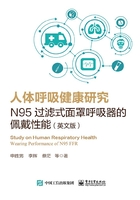
04 Chapter 4 Investigation of the flow-field in the upper respiratory system when wearing N95 FFR
◆ Introduction
◆ Modeling of full breathing cycles
◆ Flow field of a full breathing cycle
◆ Discussion
◆ Conclusion
This chapter presents a reverse modeling of the headform when wearing a filtering facepiece respirator (FFR) and a CFD simulation based on the modeling.The whole model containing the upper respiratory airway,headform and FFR was directly recorded by computed tomography scanning,and a medical contrast medium was used to make the FFR"visible".The FFR was normally worn by the subject during CT scanning so that the actual deformation of both the FFR and the face muscles during contact can be objectively conserved.The reverse modeling approach was introduced to rebuild the geometric model and convert it into a CFD solvable model.In this model,we conducted a transient numerical simulation of air flow containing carbon dioxide,thermal dynamics,pressure and wall shear stress distribution in the respiratory system,where an individual wearing an FFR was taken into consideration.The breathing cycle was described as a time-dependent profile of the air velocity through the respiratory airway.The result showed that wearing the N95 FFR resulted in CO2 accumulation,an increase in temperature and pressure elevation inside the FFR cavity.The volume fraction of CO2 reaches 1.2%after 7 breathing cycles and then is maintained at 3.04%on average.The wearers re-inhale excessive CO2 in every breathing cycle from the FFR cavity.The air temperature in the FFR cavity increases rapidly at first and then stays close to the exhaled temperature.Compared to not wearing an FFR,wearers have to increase approximately 90 Pa more pressure to keep the same breathing flow rate of 30.54 L/min after wearing an FFR.The nasal vestibule bears more wall shear stress than any other area in the airway.